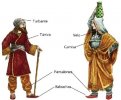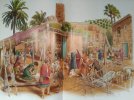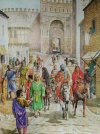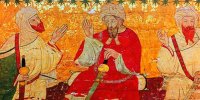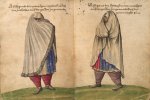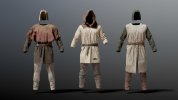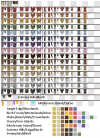The Dornish climate favors loose, layered robes. Dornish nobles prefer to wear robes of linen, satin, silk, or samite, accessorized with jeweled belts. Dornish armor is heavily enameled and inlaid with burnished copper, shining silver, and soft red gold, with cloaks over it to keep the sun off. Similarly, it is Dornish fashion to wrap helmets in long scarfs, to prevent the sun from beating down upon it. When crossing the deserts of Dorne during daytime, veils are used to keep the sands out of their faces.
Block Change Request: Cultural and Climate Variants for Clotheslines
- Thread starter Margaery_Tyrell
- Start date
-
The Spring 2023 edition of The Rookery is now out! Take a look to see the latest builds, guides, progress and development updates on the upcoming 1.18.2 switch. You can read it here:
https://indd.adobe.com/view/f943da18-ed77-4d55-845d-fee9bfa14247
You are using an out of date browser. It may not display this or other websites correctly.
You should upgrade or use an alternative browser.
You should upgrade or use an alternative browser.
I love the designs so far, especially that little northern fur coat. I am a bit worried about all the colours though. Could we split them up into two blocks for farmers/ normal townsfolk and a fancier alternative for higher class individuals? An other important factor to keep in mind is that the mushroom biome is predominantly used in the Southern Reach and Red Mountains. These areas are culturally westerosi and wouldn't see any Rhoynish influences. It might be better to separate the desert- and mushroom biome versions, allowing us to distinguish between normal Dorne and Rhyonish Dorne.
I think going the route of showing more colors (not every single variant as Cash and Endy mentioned) is a good idea. Commoners and peasants of the late medieval era definitely had access to colorful clothing, and I've read a lot of sources that claim it was quite predominant. I think peasants wearing only brown and undyed linens was actually a bit of a cliché' you see represented a lot in media. Not to say they wouldn't wear undyed or less flashy colors too. I think it's just more of a mix. A normal peasant that wasn't under hard times would probably be able to get access to colorful garments (but they wouldn't be as fancy or intricate as higher class clothing).
I think splitting them up somehow would be a good idea. Keeping the more common colors of yellow/red/blue/green to represent common clothing. Saving purple/pink stuff for more noble clothes. I don't know how easy it would be to split these up though. Also, depending on the richness and saturation of the dye, it would be more likely to be used by nobles and richer folk. This will be a bit hard to represent without going crazy in variants for the clothing. So I think projects should just use their best judgement when adding these more colorful variants of clothing. A blue garment hanging in a noble's estate could be interpreted as something fancy, and that same garment hanging in a peasant's yard could be interpreted as something more common. I think it's about the presentation and area you put these clothes as well, and I think allowing there to be room for interpretation is a good thing, imo.
"Among the peasantry, wool was generally shorn from the sheep and spun into the thread for the cloth by the women of the family. Dyes were common, so even the lower class peasants frequently wore colourful clothing."
Here's some sources: https://www.castlesandmanorhouses.com/life_03_clothing.htm
/French-Medieval-Clothing-58fa2c413df78ca159cf3ade.jpg)
 www.thoughtco.com
www.thoughtco.com
I think splitting them up somehow would be a good idea. Keeping the more common colors of yellow/red/blue/green to represent common clothing. Saving purple/pink stuff for more noble clothes. I don't know how easy it would be to split these up though. Also, depending on the richness and saturation of the dye, it would be more likely to be used by nobles and richer folk. This will be a bit hard to represent without going crazy in variants for the clothing. So I think projects should just use their best judgement when adding these more colorful variants of clothing. A blue garment hanging in a noble's estate could be interpreted as something fancy, and that same garment hanging in a peasant's yard could be interpreted as something more common. I think it's about the presentation and area you put these clothes as well, and I think allowing there to be room for interpretation is a good thing, imo.
"Among the peasantry, wool was generally shorn from the sheep and spun into the thread for the cloth by the women of the family. Dyes were common, so even the lower class peasants frequently wore colourful clothing."
Here's some sources: https://www.castlesandmanorhouses.com/life_03_clothing.htm
/French-Medieval-Clothing-58fa2c413df78ca159cf3ade.jpg)
Here's How You Could Have Been Fashionable in the Middle Ages
What kind of material did people use to make clothing in the Middle Ages, and what types of outfits did medieval people wear?
Reds and yellows (thus oranges too) and blues were easily obtainable from many sources, so their use was quite spread, alongside the natural colours of the textiles used. Undergaments, worn to catch sweat and keep exterior clothing clean, were washed more often and usually weren't dyed, as the tint would wear off fast, unlike top layers like tunics, robes, shawls, pants... since they were more expensive. For this reason I think simpler undyed clothes should predominate on the clotheslines, just because those garments were washed more often.
Greens, pinks, purples and richer colours, alongside patterns and more intricate emboridery were used more by the higher classes due to their cost and rarity. Saturation, as poined by ItsPabs, is an important factor. Dyes need a mordant, a substance that holds the tint on the cloth. Mordants vary widely in quality an effectivenes, so more saturated, rich colours would be worn by the elite, since they were the ones able to afford them.
Greens, pinks, purples and richer colours, alongside patterns and more intricate emboridery were used more by the higher classes due to their cost and rarity. Saturation, as poined by ItsPabs, is an important factor. Dyes need a mordant, a substance that holds the tint on the cloth. Mordants vary widely in quality an effectivenes, so more saturated, rich colours would be worn by the elite, since they were the ones able to afford them.
Yeah, having said all that, i think this would be the easier and smarter solution. A blue cloth could be interpreted as both commoner clothes and rich, luxurious merchant textiles depending on the context where it's used. As long as the pieces aren't super bright, they could be used on both cases. It was suggested before the creation of a high class clothesline. I think this would be a cool addition. Combined with the regular would make a clear distintion between high class and commoner clothes.I think it's about the presentation and area you put these clothes as well, and I think allowing there to be room for interpretation is a good thing, imo.
Images of dyed yarns and textiles showing a range of colours moderately easy to obtain

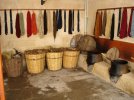
Looking good so far, Cash! I haven't had time to read through the above discussion yet; I just want to remind about the constraint that "the cloth textures for each biome should be more or less interchangeable with each other preference-wise". Probably, this means that for the basic clothes block (the one that will be replaced by the new biome-dependent textures) we should stick to clothing types which are fairly common or ambiguous within the context of the region each biome represents, and use relatively toned-down colors.
Thanks for those notes guys, the extra direction will help guide the subsequent iterations and tests.
I’ll do additional versions of each set with muted variants of each color.
Great point that the colored clothes wouldn’t be washed too often to avoid color fading, but worth noting that these blocks are also commonly used as generic wardrobes/clothing storage, so there might still be some scope for the inclusion of colors for that purpose.
I suspect we’re probably going to want to avoid adding a new “middle/high class clothing” block to avoid the need to update every high class house we’ve got currently. Hopefully there’s a middle ground to be found so the clothes featured could reasonably appear in a house of any degree of wealth.
Also, if we wanted to use the desert biome to distinguish between Westerosi Dorne and Rhoynish Dorne, the desert biome will need to be universally updated and added across Dorne. Right now it produces the grass the same color as Plains and isn’t widely used.
I’ll do additional versions of each set with muted variants of each color.
Great point that the colored clothes wouldn’t be washed too often to avoid color fading, but worth noting that these blocks are also commonly used as generic wardrobes/clothing storage, so there might still be some scope for the inclusion of colors for that purpose.
I suspect we’re probably going to want to avoid adding a new “middle/high class clothing” block to avoid the need to update every high class house we’ve got currently. Hopefully there’s a middle ground to be found so the clothes featured could reasonably appear in a house of any degree of wealth.
Also, if we wanted to use the desert biome to distinguish between Westerosi Dorne and Rhoynish Dorne, the desert biome will need to be universally updated and added across Dorne. Right now it produces the grass the same color as Plains and isn’t widely used.
I wish it was the same color as plains, its a hideous bluish color
Why are you displaying elements of my wardrobe D:<I can take a stab at more region specific options, just need specific examples and reference shots.
View attachment 8451
This one came in handy.
Would also be easy to add mud stains/signs of weathering to clothes in places like the Neck and the Riverlands, or color combos like green/gold tunics.
Keep in mind The Arbor and southern Reach aren't Birch Forest, but rather Mushroom Island. That could potentially be an issue as it would be a bit weird seen the Dorne specific clothes at Oldtown, for example. I think dornish clothes should appear in Desert biome. If some project in the Mushroom Island side of Dorne wants to have the local variety then just change the biome underneath the clothesline block. That wouldn't be necessary most of the time, imo, as the Mushroom Island area of Dorne is the one with less rhoynish influence, except the Tor, which is somewhat transitional. I know recently some areas of Dorne got their biome changed from Desert to Mushroom Island but thats just beacuse at the moment Desert biome coloring does not suit the location at all. Once that's fixed they would probably flip back.
Last edited:
I really dig the new desaturated colours, but I think you could go even further. And I would suggest that you instead of using a single hue you could introduce a short range of hues so that there is some internal variation in the texture. Like a hue shift for the darker tones and perhaps random noise along a range of hues.
Share:





